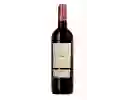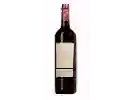
Château La CoustarelleL'Éclat
In the mouth this red wine is a powerful with a nice balance between acidity and tannins.
This wine generally goes well with poultry, beef or lamb.
Taste structure of the L'Éclat from the Château La Coustarelle
Light | Bold | |
Smooth | Tannic | |
Dry | Sweet | |
Soft | Acidic |
In the mouth the L'Éclat of Château La Coustarelle in the region of South West is a powerful with a nice balance between acidity and tannins.
Food and wine pairings with L'Éclat
Pairings that work perfectly with L'Éclat
Original food and wine pairings with L'Éclat
The L'Éclat of Château La Coustarelle matches generally quite well with dishes of beef, lamb or poultry such as recipes of tournedos rossini with port sauce, berber giblet frying pan or chicken wok with chinese noodles.
Details and technical informations about Château La Coustarelle's L'Éclat.
Discover the grape variety: Malbec
Malbec, a high-yielding red grape variety, produces tannic and colourful wines. It is produced in different wine-growing regions and changes its name according to the grape variety. Called Auxerrois in Cahors, Malbec in Bordeaux, it is also known as Côt. 6,000 hectares of the Malbec grape are grown in France (in decline since the 1950s). Malbec is also very successful in Argentina. The country has become the world's leading producer of Malbec and offers wines with great potential.
Informations about the Château La Coustarelle
The Château La Coustarelle is one of of the world's greatest estates. It offers 13 wines for sale in the of South West to come and discover on site or to buy online.
The wine region of South West
The South-West is a large territorial area of France, comprising the administrative regions of Aquitaine, Limousin and Midi-Pyrénées. However, as far as the French wine area is concerned, the South-West region is a little less clear-cut, as it excludes Bordeaux - a wine region so productive that it is de facto an area in its own right. The wines of the South West have a Long and eventful history. The local rivers play a key role, as they were the main trade routes to bring wines from traditional regions such as Cahors, Bergerac, Buzet and Gaillac to their markets.
News related to this wine
Chablis: #locationmatters by Yang LU
On December 10, 2020, four Hong Kong personalities discussed Chablis wines on a live webinar: Yang LU, Master Sommelier and Official Bourgogne Wines Ambassador, Debra MEIBURG, Master of Wine, Ivy NG, Official Bourgogne Wines Ambassador and Rebecca LEUNG, wine expert. In this first 90-second clip, Yang LU explains how location is the key to understanding “Why Chablis is special”. #Chablis #PureChablis ...
The Saint-Véran appellation investigated through its geology and geography
The Bourgogne Wine Board (BIVB) invites you to enjoy this video in which Jean-Pierre Renard, Expert Instructor at the Ecole des Vins de Bourgogne, explains the topographical and geological characteristics of the Saint-Véran appellation.The exercice is particularly complex as there are so many variables that make up the terroir throughout its geographical area. This video is taken from the “Rendez-vous avec les vins de Bourgogne” program broadcasted in June 2021. Retrouvez-nous sur les réseaux so ...
A panel discussion about the Chablis appellation
This film is the recording of a webinar on Chablis wines organized in December 2020 with four personalities from Hong Kong: Yang LU, Master Sommelier and Official Bourgogne Wines Ambassador, Debra MEIBURG, Master of Wine, Ivy NG, Official Bourgogne Wines Ambassador and Rebecca LEUNG, wine expert. They explain the purity of Chablis wines, discuss the latest vintages, and also talk about food and wine pairings, as well as global warming and the transition to more sustainable practices. #Chablis #P ...
The word of the wine: Yeast
Micro-organisms at the base of all fermentative processes. A wide variety of yeasts live and thrive naturally in the vineyard, provided that treatments do not destroy them. Unfortunately, their replacement by laboratory-selected yeasts is often the order of the day and contributes to the standardization of the wine. Yeasts are indeed involved in the development of certain aromas.














